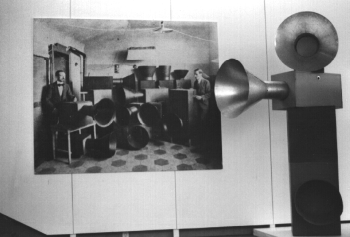
Reconstruction of intonarumori by Fred K. Prieberg, 1977.
Displayed at the 'Écouter par les yeux' exhibit, Musée d'Art Moderne de la Ville de Paris, 1980.

Reconstruction of intonarumori by Fred
K. Prieberg, 1977.
Displayed at the 'Écouter par les yeux' exhibit, Musée d'Art
Moderne de la Ville de Paris, 1980.
The Italian Futurist, Luigi Russolo came to sound from painting trough poetry. He wanted to do for music what F. T. Marinetti was doing for poetry with his parole in liberta. In Russolo's often quoted manifesto from 1913, l'arte di rumori, Russolo proposed an Art of Noise to break through the limiting canvas which cultivated 'pure sounds' had placed on music. He wanted to reverse the processes of articulatory control which had produced the restrictive circle of pure sounds, and return to the creation of noise and the sense wonderment which it had evoked from earlier people. It was his contention that the process which reduced noises into musical harmonics had also robbed sound of its ability to arouse the emotions.
He wanted to go back to the roots of sound in modern instruments, and also suggested using the sounds of nature (wind, water, and various animal sounds), the sounds of the modern urban environment, and 'all the noises which are made with the mouth without talking or singing.' He had no formal training in acoustics, instrument building, or musicianship, however as an enthusiastic amateur scientist, he proceeded to categorize the basic sounds in his environment and build instruments to mimic these sounds. With another painter, Ugo Piatti, they began to experiment with a lot of different materials and taught themselves instrument building. For example they would try such things as soaking drum heads in various chemicals until they would get the sound from it that they wanted.
The first instrument which they build for their intonarumori, was something which they called an 'exploder' which could reproduce in a series of ten whole tones, the characteristics of a motor starting up. They built whole orchestras of 'cracklers, roarers, bubblers, thunderers, bursters, etc.' and performed pieces which Russolo had written for them, or used them with more conventional musical instruments, and with parole in liberta declamations. With these intonarumori, Russolo could explore microtonal and improvisational structures (as well as graphic notation techniques) which were largely unheard of at that time. Also, the identification of the composer with the instrument builder and performer had also been unheard of since the Middle Ages, but has become a prominent feature of experimental music since the nineteen fifties.
Like many of the Italian Futurists, Russolo joined the Motorcycle Corp during World War I, and was severely wounded, from which he never quite recovered. After the war, he gave a concert in Paris in 1921 with the intonarumori and caught the attention of Ravel and Stravinsky. The chorus of frogs near the end of Ravel's opera, L'Enfant et les sortilèges was inspired by hearing Russolo's 'croaker' instrument. Stravinsky had planned to use the intonarumori in Les Noces but gave up for technical reasons. Edgar Varese was also very interested in Russolo's work and did a presentation of Russolo's new Rumorarmonio instrument in 1929.
Russolo later built four noise harmoniums which were keyboard instruments using a combination of features from his intonarumori. These were a kind of precursor to the modern 'sampler' instrument -- particularly the ones which have a preset variety of sounds already built into them. Russolo also wanted to build what he called an enharmonic piano which was a kind of large mechanized prepared piano. He had hoped to sell it to be used in silent movies, but the invention of 'talkies' put the end to his plans.
In the last years of his life, Russolo lived in obscurity in Paris on a small government pension. He returned to painting, and was embittered and frustrated by 'all the time he had wasted' as an instrument builder. He also got heavily involved in yoga. Most of his musical experiments were lost (thrown away by his brother) when he died. His original intonarumori were destroyed in a fire during World War II. There have been attempts to build facsimiles of these instruments from what little remained of Russolo's documents as well as from accounts of them at the time.
Russolo's manifestos on noise, can be found translated in English in The Art of Noises, translated from the Italian with an introduction by Barclay Brown (New York: Pendragon Press, Monographs in Musicology, no. 6, 1986). The definitive work in Italian on Russolo is G. F. Maffina's LUIGI RUSSOLO E L'ARTE DEI RUMORI con tutti gli scritti musicali (Torino: Martano Editore, 1978).